Human Resource Management Report: Analysis of McDonald's HRM
VerifiedAdded on 2020/06/03
|13
|4132
|36
Report
AI Summary
This report provides a comprehensive analysis of human resource management (HRM) practices within McDonald's. It begins with an introduction to the importance of HRM and its role in organizational success, followed by an examination of the Guest model of HRM and its application within McDonald's. The report differentiates between HRM and personnel management, highlighting the strategic perspectives of HRM. It explores the implementation of flexible working models, types of flexibility, and their implications for both employees and employers, considering the impacts of changes in the labor market. Further, the report addresses discrimination in business, practical implications of equal opportunities legislation, and approaches to managing equal opportunities. It also covers various performance management methods, approaches to employee welfare, the implications of health and safety laws, and other topical issues impacting HR practices within McDonald's. The conclusion summarizes the key findings and provides recommendations for effective HRM strategies. The report references several academic sources to support its analysis.
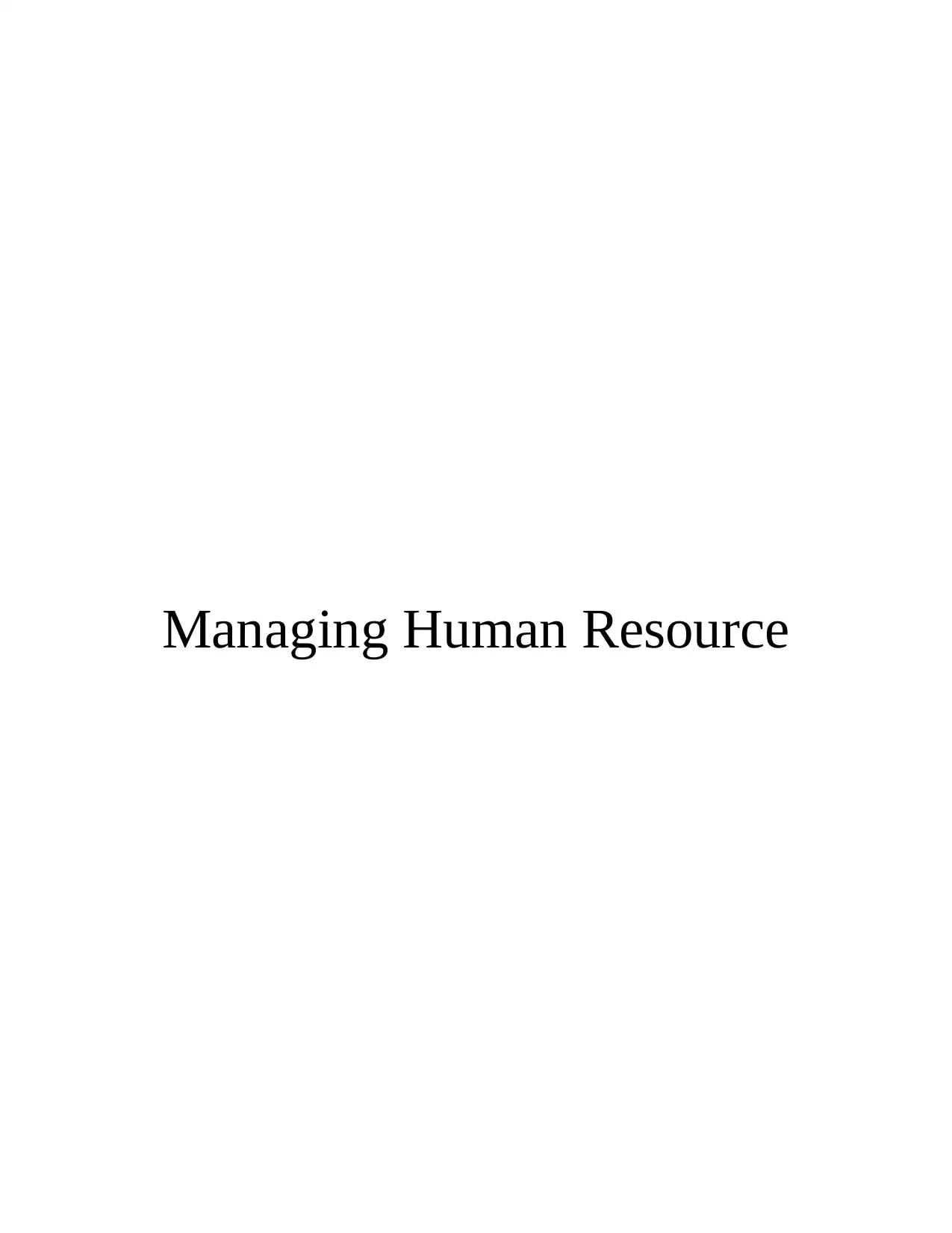
Managing Human Resource
Paraphrase This Document
Need a fresh take? Get an instant paraphrase of this document with our AI Paraphraser
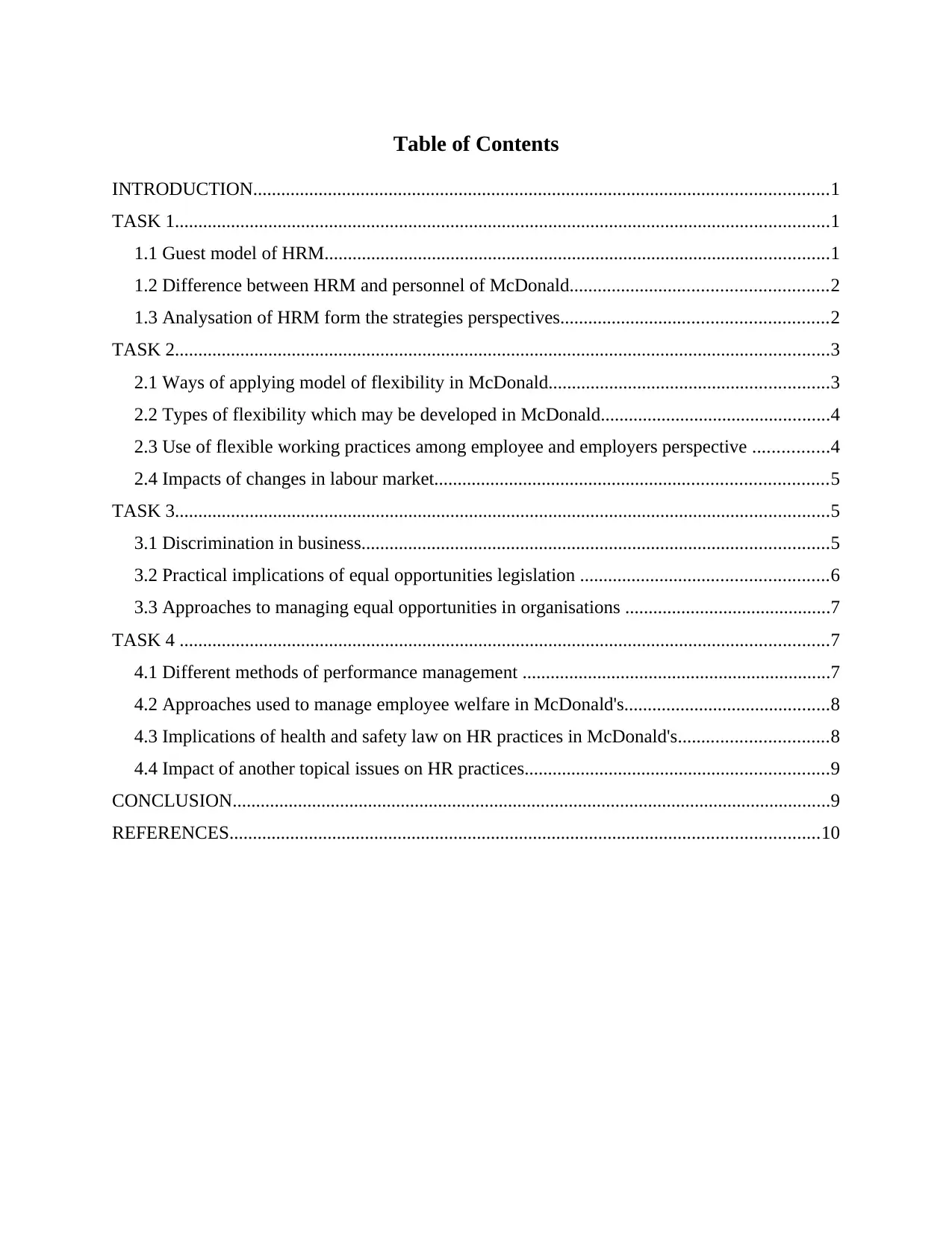
Table of Contents
INTRODUCTION...........................................................................................................................1
TASK 1............................................................................................................................................1
1.1 Guest model of HRM............................................................................................................1
1.2 Difference between HRM and personnel of McDonald.......................................................2
1.3 Analysation of HRM form the strategies perspectives.........................................................2
TASK 2............................................................................................................................................3
2.1 Ways of applying model of flexibility in McDonald............................................................3
2.2 Types of flexibility which may be developed in McDonald.................................................4
2.3 Use of flexible working practices among employee and employers perspective ................4
2.4 Impacts of changes in labour market....................................................................................5
TASK 3............................................................................................................................................5
3.1 Discrimination in business....................................................................................................5
3.2 Practical implications of equal opportunities legislation .....................................................6
3.3 Approaches to managing equal opportunities in organisations ............................................7
TASK 4 ...........................................................................................................................................7
4.1 Different methods of performance management ..................................................................7
4.2 Approaches used to manage employee welfare in McDonald's............................................8
4.3 Implications of health and safety law on HR practices in McDonald's................................8
4.4 Impact of another topical issues on HR practices.................................................................9
CONCLUSION................................................................................................................................9
REFERENCES..............................................................................................................................10
INTRODUCTION...........................................................................................................................1
TASK 1............................................................................................................................................1
1.1 Guest model of HRM............................................................................................................1
1.2 Difference between HRM and personnel of McDonald.......................................................2
1.3 Analysation of HRM form the strategies perspectives.........................................................2
TASK 2............................................................................................................................................3
2.1 Ways of applying model of flexibility in McDonald............................................................3
2.2 Types of flexibility which may be developed in McDonald.................................................4
2.3 Use of flexible working practices among employee and employers perspective ................4
2.4 Impacts of changes in labour market....................................................................................5
TASK 3............................................................................................................................................5
3.1 Discrimination in business....................................................................................................5
3.2 Practical implications of equal opportunities legislation .....................................................6
3.3 Approaches to managing equal opportunities in organisations ............................................7
TASK 4 ...........................................................................................................................................7
4.1 Different methods of performance management ..................................................................7
4.2 Approaches used to manage employee welfare in McDonald's............................................8
4.3 Implications of health and safety law on HR practices in McDonald's................................8
4.4 Impact of another topical issues on HR practices.................................................................9
CONCLUSION................................................................................................................................9
REFERENCES..............................................................................................................................10
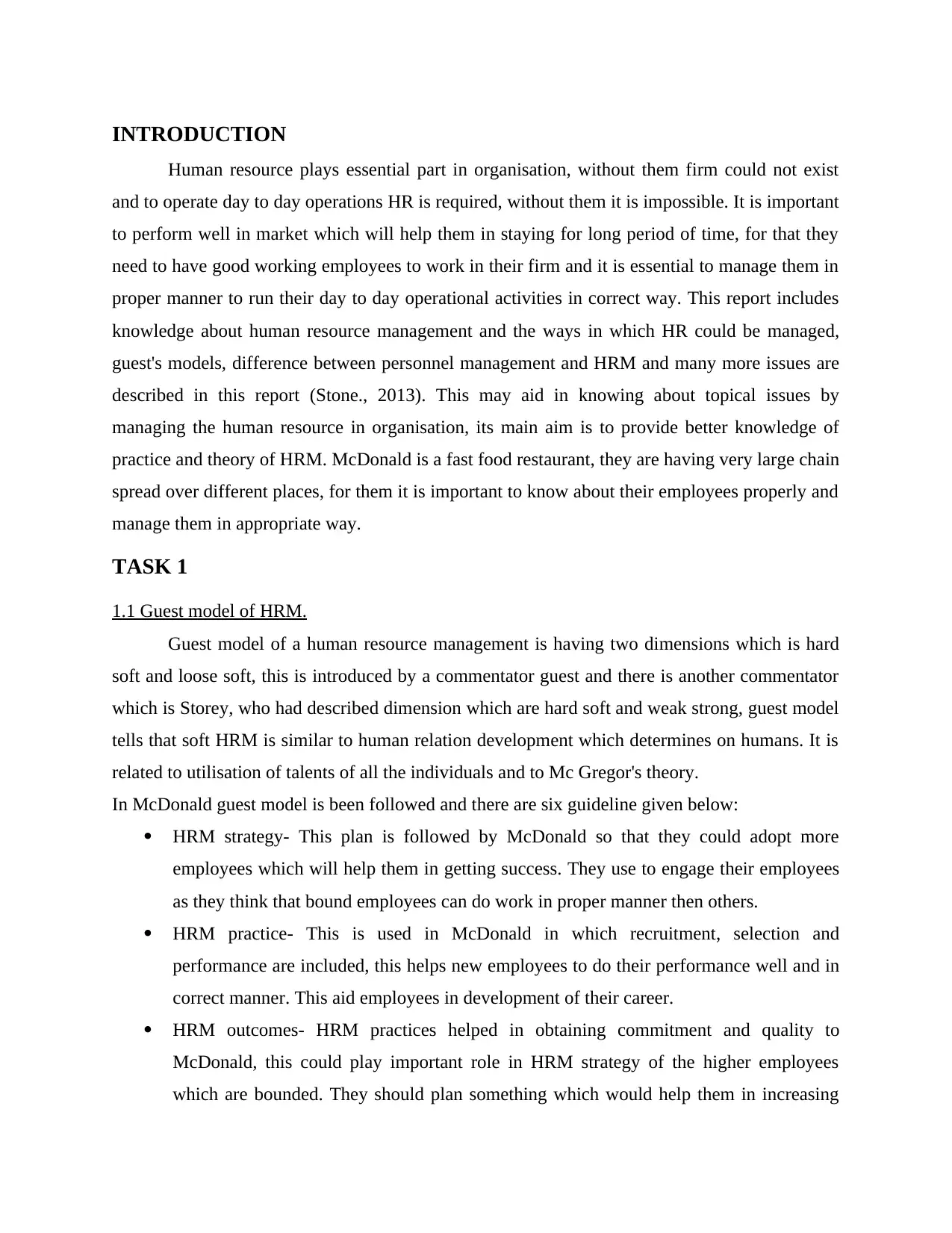
INTRODUCTION
Human resource plays essential part in organisation, without them firm could not exist
and to operate day to day operations HR is required, without them it is impossible. It is important
to perform well in market which will help them in staying for long period of time, for that they
need to have good working employees to work in their firm and it is essential to manage them in
proper manner to run their day to day operational activities in correct way. This report includes
knowledge about human resource management and the ways in which HR could be managed,
guest's models, difference between personnel management and HRM and many more issues are
described in this report (Stone., 2013). This may aid in knowing about topical issues by
managing the human resource in organisation, its main aim is to provide better knowledge of
practice and theory of HRM. McDonald is a fast food restaurant, they are having very large chain
spread over different places, for them it is important to know about their employees properly and
manage them in appropriate way.
TASK 1
1.1 Guest model of HRM.
Guest model of a human resource management is having two dimensions which is hard
soft and loose soft, this is introduced by a commentator guest and there is another commentator
which is Storey, who had described dimension which are hard soft and weak strong, guest model
tells that soft HRM is similar to human relation development which determines on humans. It is
related to utilisation of talents of all the individuals and to Mc Gregor's theory.
In McDonald guest model is been followed and there are six guideline given below:
HRM strategy- This plan is followed by McDonald so that they could adopt more
employees which will help them in getting success. They use to engage their employees
as they think that bound employees can do work in proper manner then others.
HRM practice- This is used in McDonald in which recruitment, selection and
performance are included, this helps new employees to do their performance well and in
correct manner. This aid employees in development of their career.
HRM outcomes- HRM practices helped in obtaining commitment and quality to
McDonald, this could play important role in HRM strategy of the higher employees
which are bounded. They should plan something which would help them in increasing
Human resource plays essential part in organisation, without them firm could not exist
and to operate day to day operations HR is required, without them it is impossible. It is important
to perform well in market which will help them in staying for long period of time, for that they
need to have good working employees to work in their firm and it is essential to manage them in
proper manner to run their day to day operational activities in correct way. This report includes
knowledge about human resource management and the ways in which HR could be managed,
guest's models, difference between personnel management and HRM and many more issues are
described in this report (Stone., 2013). This may aid in knowing about topical issues by
managing the human resource in organisation, its main aim is to provide better knowledge of
practice and theory of HRM. McDonald is a fast food restaurant, they are having very large chain
spread over different places, for them it is important to know about their employees properly and
manage them in appropriate way.
TASK 1
1.1 Guest model of HRM.
Guest model of a human resource management is having two dimensions which is hard
soft and loose soft, this is introduced by a commentator guest and there is another commentator
which is Storey, who had described dimension which are hard soft and weak strong, guest model
tells that soft HRM is similar to human relation development which determines on humans. It is
related to utilisation of talents of all the individuals and to Mc Gregor's theory.
In McDonald guest model is been followed and there are six guideline given below:
HRM strategy- This plan is followed by McDonald so that they could adopt more
employees which will help them in getting success. They use to engage their employees
as they think that bound employees can do work in proper manner then others.
HRM practice- This is used in McDonald in which recruitment, selection and
performance are included, this helps new employees to do their performance well and in
correct manner. This aid employees in development of their career.
HRM outcomes- HRM practices helped in obtaining commitment and quality to
McDonald, this could play important role in HRM strategy of the higher employees
which are bounded. They should plan something which would help them in increasing
⊘ This is a preview!⊘
Do you want full access?
Subscribe today to unlock all pages.

Trusted by 1+ million students worldwide
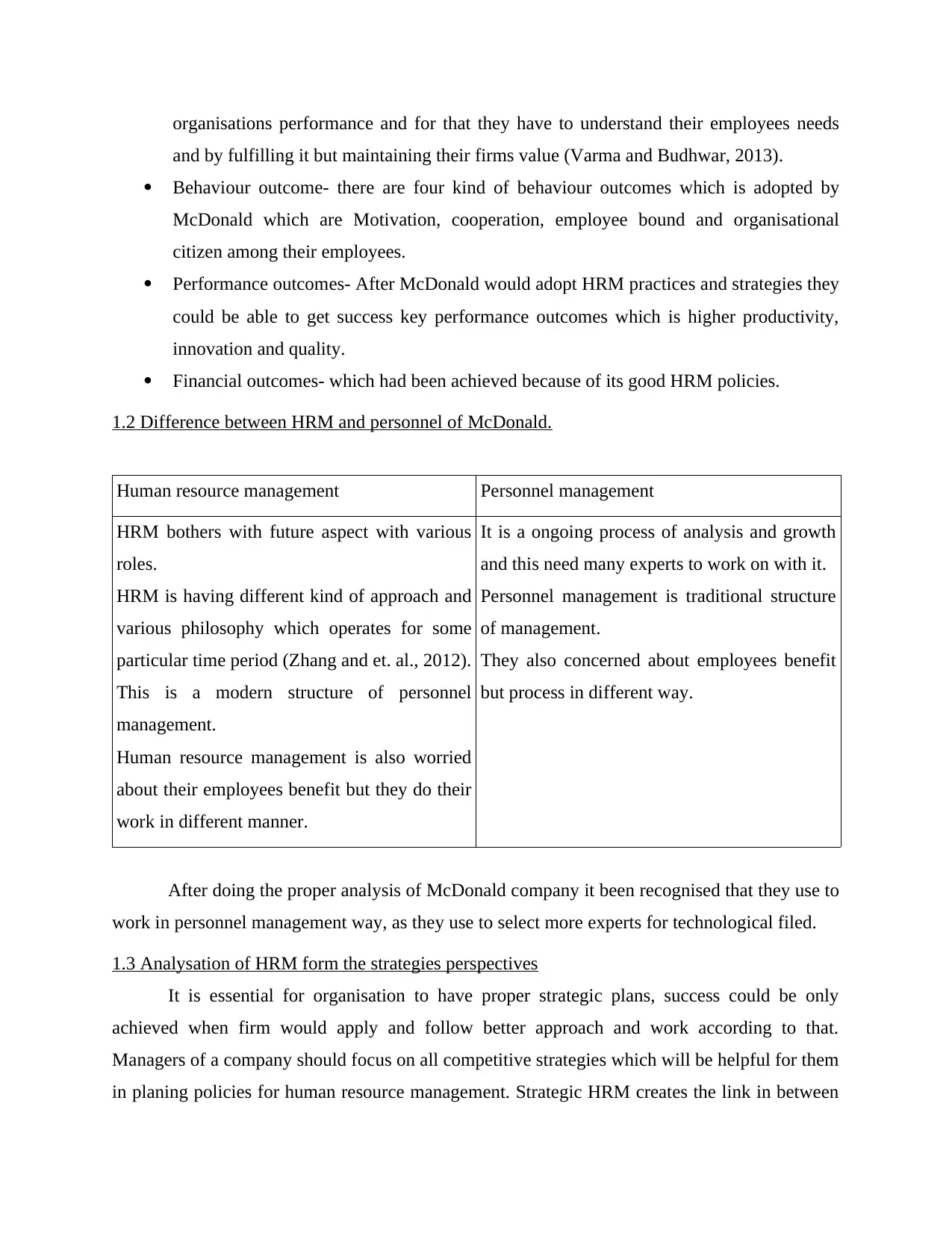
organisations performance and for that they have to understand their employees needs
and by fulfilling it but maintaining their firms value (Varma and Budhwar, 2013).
Behaviour outcome- there are four kind of behaviour outcomes which is adopted by
McDonald which are Motivation, cooperation, employee bound and organisational
citizen among their employees.
Performance outcomes- After McDonald would adopt HRM practices and strategies they
could be able to get success key performance outcomes which is higher productivity,
innovation and quality.
Financial outcomes- which had been achieved because of its good HRM policies.
1.2 Difference between HRM and personnel of McDonald.
Human resource management Personnel management
HRM bothers with future aspect with various
roles.
HRM is having different kind of approach and
various philosophy which operates for some
particular time period (Zhang and et. al., 2012).
This is a modern structure of personnel
management.
Human resource management is also worried
about their employees benefit but they do their
work in different manner.
It is a ongoing process of analysis and growth
and this need many experts to work on with it.
Personnel management is traditional structure
of management.
They also concerned about employees benefit
but process in different way.
After doing the proper analysis of McDonald company it been recognised that they use to
work in personnel management way, as they use to select more experts for technological filed.
1.3 Analysation of HRM form the strategies perspectives
It is essential for organisation to have proper strategic plans, success could be only
achieved when firm would apply and follow better approach and work according to that.
Managers of a company should focus on all competitive strategies which will be helpful for them
in planing policies for human resource management. Strategic HRM creates the link in between
and by fulfilling it but maintaining their firms value (Varma and Budhwar, 2013).
Behaviour outcome- there are four kind of behaviour outcomes which is adopted by
McDonald which are Motivation, cooperation, employee bound and organisational
citizen among their employees.
Performance outcomes- After McDonald would adopt HRM practices and strategies they
could be able to get success key performance outcomes which is higher productivity,
innovation and quality.
Financial outcomes- which had been achieved because of its good HRM policies.
1.2 Difference between HRM and personnel of McDonald.
Human resource management Personnel management
HRM bothers with future aspect with various
roles.
HRM is having different kind of approach and
various philosophy which operates for some
particular time period (Zhang and et. al., 2012).
This is a modern structure of personnel
management.
Human resource management is also worried
about their employees benefit but they do their
work in different manner.
It is a ongoing process of analysis and growth
and this need many experts to work on with it.
Personnel management is traditional structure
of management.
They also concerned about employees benefit
but process in different way.
After doing the proper analysis of McDonald company it been recognised that they use to
work in personnel management way, as they use to select more experts for technological filed.
1.3 Analysation of HRM form the strategies perspectives
It is essential for organisation to have proper strategic plans, success could be only
achieved when firm would apply and follow better approach and work according to that.
Managers of a company should focus on all competitive strategies which will be helpful for them
in planing policies for human resource management. Strategic HRM creates the link in between
Paraphrase This Document
Need a fresh take? Get an instant paraphrase of this document with our AI Paraphraser
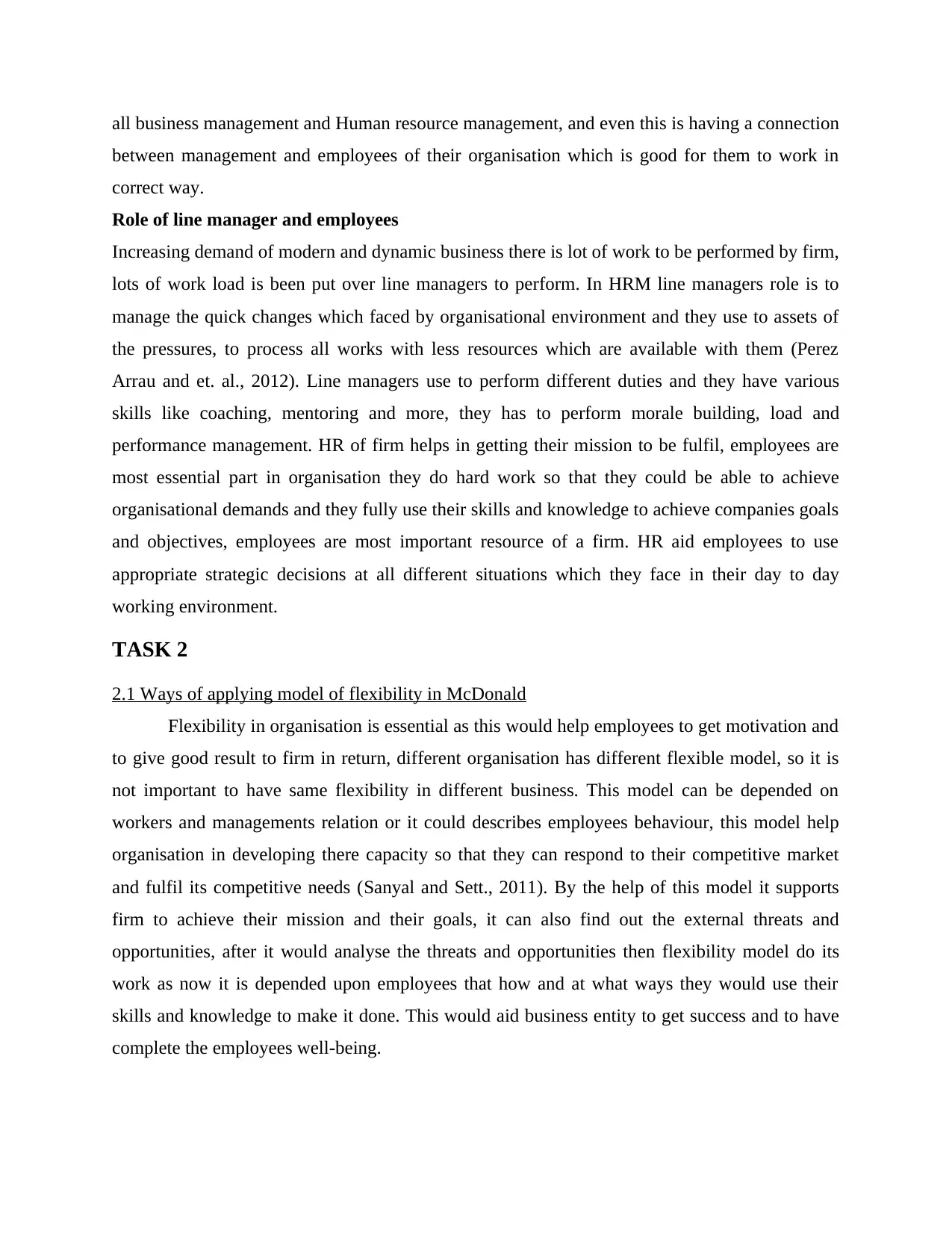
all business management and Human resource management, and even this is having a connection
between management and employees of their organisation which is good for them to work in
correct way.
Role of line manager and employees
Increasing demand of modern and dynamic business there is lot of work to be performed by firm,
lots of work load is been put over line managers to perform. In HRM line managers role is to
manage the quick changes which faced by organisational environment and they use to assets of
the pressures, to process all works with less resources which are available with them (Perez
Arrau and et. al., 2012). Line managers use to perform different duties and they have various
skills like coaching, mentoring and more, they has to perform morale building, load and
performance management. HR of firm helps in getting their mission to be fulfil, employees are
most essential part in organisation they do hard work so that they could be able to achieve
organisational demands and they fully use their skills and knowledge to achieve companies goals
and objectives, employees are most important resource of a firm. HR aid employees to use
appropriate strategic decisions at all different situations which they face in their day to day
working environment.
TASK 2
2.1 Ways of applying model of flexibility in McDonald
Flexibility in organisation is essential as this would help employees to get motivation and
to give good result to firm in return, different organisation has different flexible model, so it is
not important to have same flexibility in different business. This model can be depended on
workers and managements relation or it could describes employees behaviour, this model help
organisation in developing there capacity so that they can respond to their competitive market
and fulfil its competitive needs (Sanyal and Sett., 2011). By the help of this model it supports
firm to achieve their mission and their goals, it can also find out the external threats and
opportunities, after it would analyse the threats and opportunities then flexibility model do its
work as now it is depended upon employees that how and at what ways they would use their
skills and knowledge to make it done. This would aid business entity to get success and to have
complete the employees well-being.
between management and employees of their organisation which is good for them to work in
correct way.
Role of line manager and employees
Increasing demand of modern and dynamic business there is lot of work to be performed by firm,
lots of work load is been put over line managers to perform. In HRM line managers role is to
manage the quick changes which faced by organisational environment and they use to assets of
the pressures, to process all works with less resources which are available with them (Perez
Arrau and et. al., 2012). Line managers use to perform different duties and they have various
skills like coaching, mentoring and more, they has to perform morale building, load and
performance management. HR of firm helps in getting their mission to be fulfil, employees are
most essential part in organisation they do hard work so that they could be able to achieve
organisational demands and they fully use their skills and knowledge to achieve companies goals
and objectives, employees are most important resource of a firm. HR aid employees to use
appropriate strategic decisions at all different situations which they face in their day to day
working environment.
TASK 2
2.1 Ways of applying model of flexibility in McDonald
Flexibility in organisation is essential as this would help employees to get motivation and
to give good result to firm in return, different organisation has different flexible model, so it is
not important to have same flexibility in different business. This model can be depended on
workers and managements relation or it could describes employees behaviour, this model help
organisation in developing there capacity so that they can respond to their competitive market
and fulfil its competitive needs (Sanyal and Sett., 2011). By the help of this model it supports
firm to achieve their mission and their goals, it can also find out the external threats and
opportunities, after it would analyse the threats and opportunities then flexibility model do its
work as now it is depended upon employees that how and at what ways they would use their
skills and knowledge to make it done. This would aid business entity to get success and to have
complete the employees well-being.
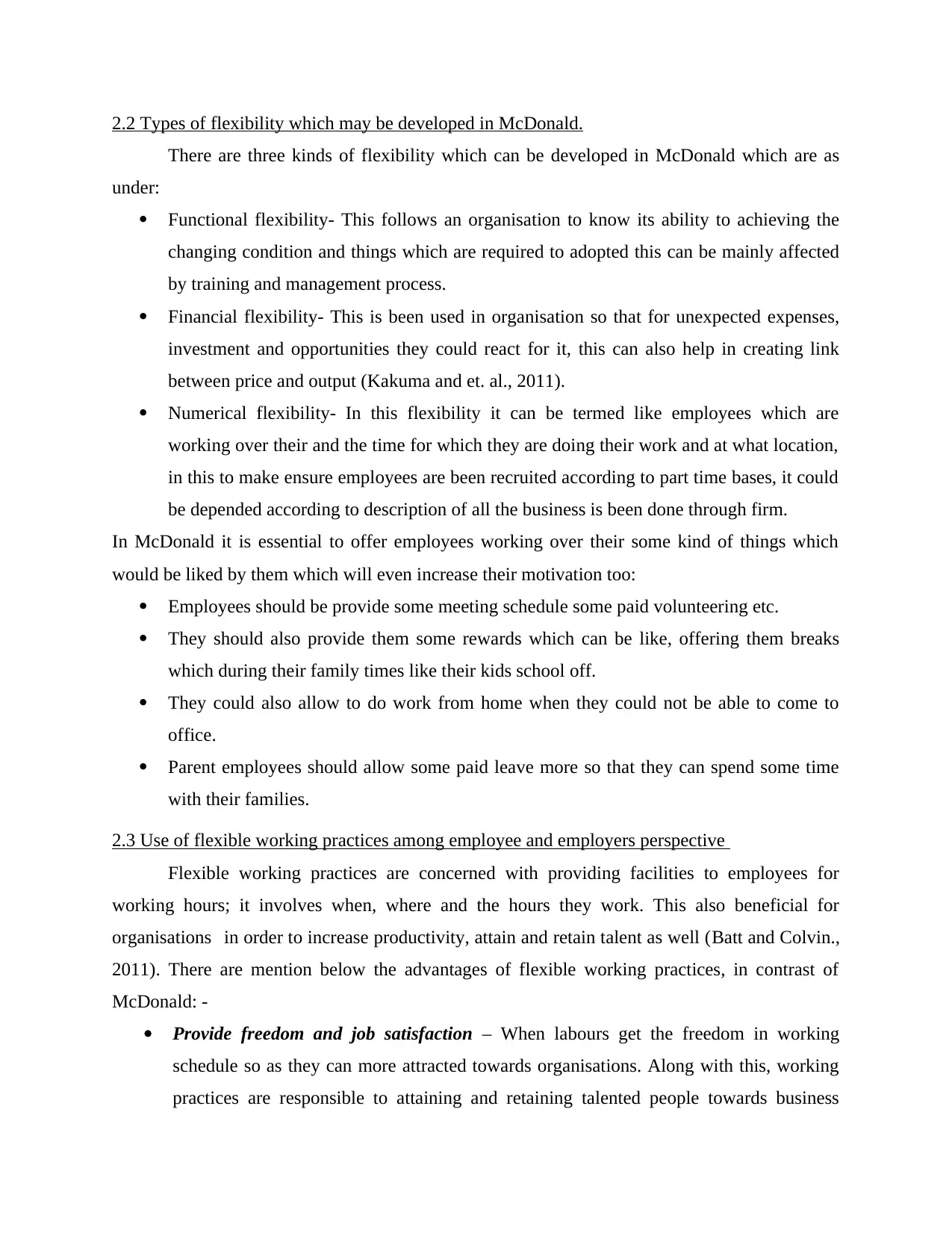
2.2 Types of flexibility which may be developed in McDonald.
There are three kinds of flexibility which can be developed in McDonald which are as
under:
Functional flexibility- This follows an organisation to know its ability to achieving the
changing condition and things which are required to adopted this can be mainly affected
by training and management process.
Financial flexibility- This is been used in organisation so that for unexpected expenses,
investment and opportunities they could react for it, this can also help in creating link
between price and output (Kakuma and et. al., 2011).
Numerical flexibility- In this flexibility it can be termed like employees which are
working over their and the time for which they are doing their work and at what location,
in this to make ensure employees are been recruited according to part time bases, it could
be depended according to description of all the business is been done through firm.
In McDonald it is essential to offer employees working over their some kind of things which
would be liked by them which will even increase their motivation too:
Employees should be provide some meeting schedule some paid volunteering etc.
They should also provide them some rewards which can be like, offering them breaks
which during their family times like their kids school off.
They could also allow to do work from home when they could not be able to come to
office.
Parent employees should allow some paid leave more so that they can spend some time
with their families.
2.3 Use of flexible working practices among employee and employers perspective
Flexible working practices are concerned with providing facilities to employees for
working hours; it involves when, where and the hours they work. This also beneficial for
organisations in order to increase productivity, attain and retain talent as well (Batt and Colvin.,
2011). There are mention below the advantages of flexible working practices, in contrast of
McDonald: -
Provide freedom and job satisfaction – When labours get the freedom in working
schedule so as they can more attracted towards organisations. Along with this, working
practices are responsible to attaining and retaining talented people towards business
There are three kinds of flexibility which can be developed in McDonald which are as
under:
Functional flexibility- This follows an organisation to know its ability to achieving the
changing condition and things which are required to adopted this can be mainly affected
by training and management process.
Financial flexibility- This is been used in organisation so that for unexpected expenses,
investment and opportunities they could react for it, this can also help in creating link
between price and output (Kakuma and et. al., 2011).
Numerical flexibility- In this flexibility it can be termed like employees which are
working over their and the time for which they are doing their work and at what location,
in this to make ensure employees are been recruited according to part time bases, it could
be depended according to description of all the business is been done through firm.
In McDonald it is essential to offer employees working over their some kind of things which
would be liked by them which will even increase their motivation too:
Employees should be provide some meeting schedule some paid volunteering etc.
They should also provide them some rewards which can be like, offering them breaks
which during their family times like their kids school off.
They could also allow to do work from home when they could not be able to come to
office.
Parent employees should allow some paid leave more so that they can spend some time
with their families.
2.3 Use of flexible working practices among employee and employers perspective
Flexible working practices are concerned with providing facilities to employees for
working hours; it involves when, where and the hours they work. This also beneficial for
organisations in order to increase productivity, attain and retain talent as well (Batt and Colvin.,
2011). There are mention below the advantages of flexible working practices, in contrast of
McDonald: -
Provide freedom and job satisfaction – When labours get the freedom in working
schedule so as they can more attracted towards organisations. Along with this, working
practices are responsible to attaining and retaining talented people towards business
⊘ This is a preview!⊘
Do you want full access?
Subscribe today to unlock all pages.

Trusted by 1+ million students worldwide
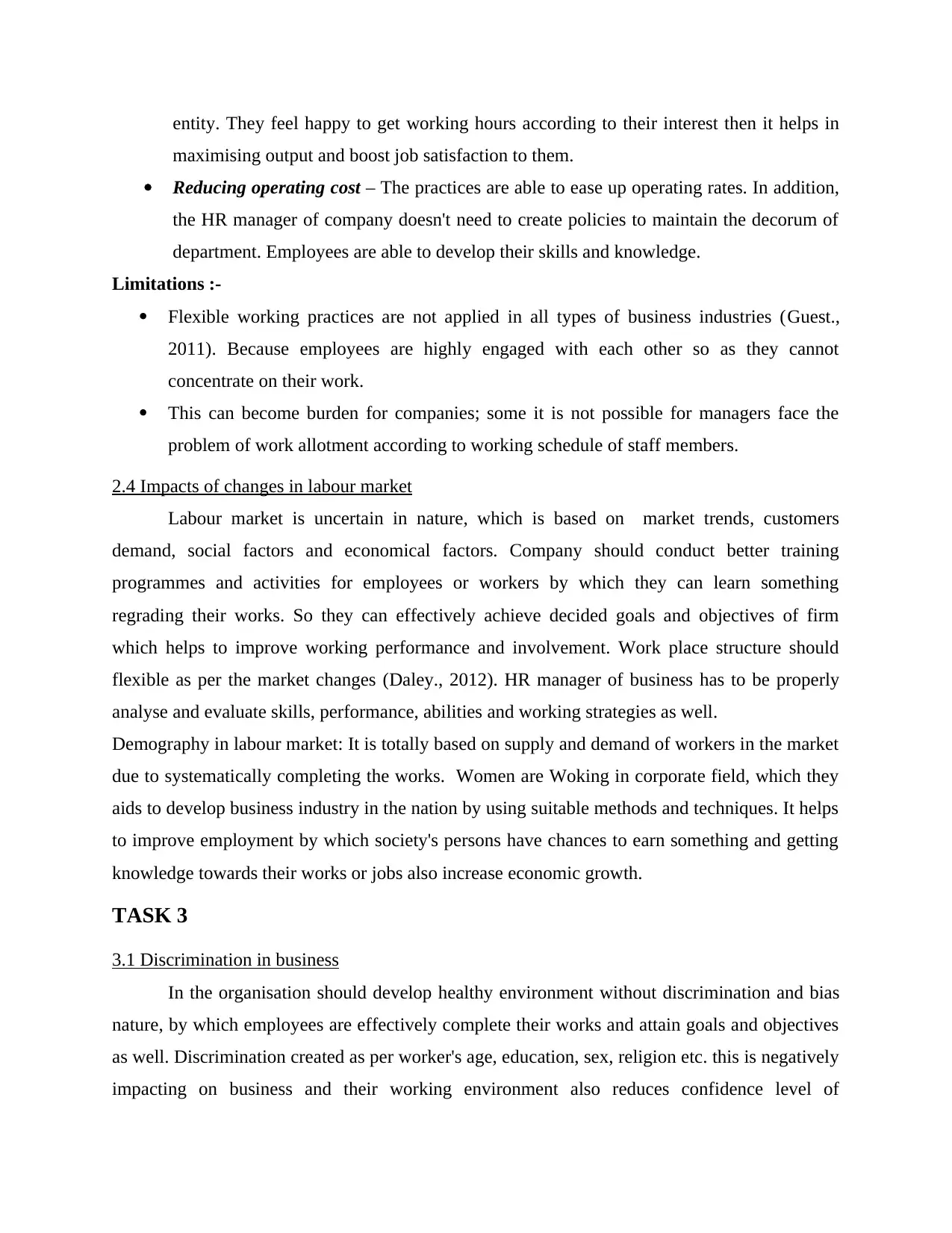
entity. They feel happy to get working hours according to their interest then it helps in
maximising output and boost job satisfaction to them.
Reducing operating cost – The practices are able to ease up operating rates. In addition,
the HR manager of company doesn't need to create policies to maintain the decorum of
department. Employees are able to develop their skills and knowledge.
Limitations :-
Flexible working practices are not applied in all types of business industries (Guest.,
2011). Because employees are highly engaged with each other so as they cannot
concentrate on their work.
This can become burden for companies; some it is not possible for managers face the
problem of work allotment according to working schedule of staff members.
2.4 Impacts of changes in labour market
Labour market is uncertain in nature, which is based on market trends, customers
demand, social factors and economical factors. Company should conduct better training
programmes and activities for employees or workers by which they can learn something
regrading their works. So they can effectively achieve decided goals and objectives of firm
which helps to improve working performance and involvement. Work place structure should
flexible as per the market changes (Daley., 2012). HR manager of business has to be properly
analyse and evaluate skills, performance, abilities and working strategies as well.
Demography in labour market: It is totally based on supply and demand of workers in the market
due to systematically completing the works. Women are Woking in corporate field, which they
aids to develop business industry in the nation by using suitable methods and techniques. It helps
to improve employment by which society's persons have chances to earn something and getting
knowledge towards their works or jobs also increase economic growth.
TASK 3
3.1 Discrimination in business
In the organisation should develop healthy environment without discrimination and bias
nature, by which employees are effectively complete their works and attain goals and objectives
as well. Discrimination created as per worker's age, education, sex, religion etc. this is negatively
impacting on business and their working environment also reduces confidence level of
maximising output and boost job satisfaction to them.
Reducing operating cost – The practices are able to ease up operating rates. In addition,
the HR manager of company doesn't need to create policies to maintain the decorum of
department. Employees are able to develop their skills and knowledge.
Limitations :-
Flexible working practices are not applied in all types of business industries (Guest.,
2011). Because employees are highly engaged with each other so as they cannot
concentrate on their work.
This can become burden for companies; some it is not possible for managers face the
problem of work allotment according to working schedule of staff members.
2.4 Impacts of changes in labour market
Labour market is uncertain in nature, which is based on market trends, customers
demand, social factors and economical factors. Company should conduct better training
programmes and activities for employees or workers by which they can learn something
regrading their works. So they can effectively achieve decided goals and objectives of firm
which helps to improve working performance and involvement. Work place structure should
flexible as per the market changes (Daley., 2012). HR manager of business has to be properly
analyse and evaluate skills, performance, abilities and working strategies as well.
Demography in labour market: It is totally based on supply and demand of workers in the market
due to systematically completing the works. Women are Woking in corporate field, which they
aids to develop business industry in the nation by using suitable methods and techniques. It helps
to improve employment by which society's persons have chances to earn something and getting
knowledge towards their works or jobs also increase economic growth.
TASK 3
3.1 Discrimination in business
In the organisation should develop healthy environment without discrimination and bias
nature, by which employees are effectively complete their works and attain goals and objectives
as well. Discrimination created as per worker's age, education, sex, religion etc. this is negatively
impacting on business and their working environment also reduces confidence level of
Paraphrase This Document
Need a fresh take? Get an instant paraphrase of this document with our AI Paraphraser
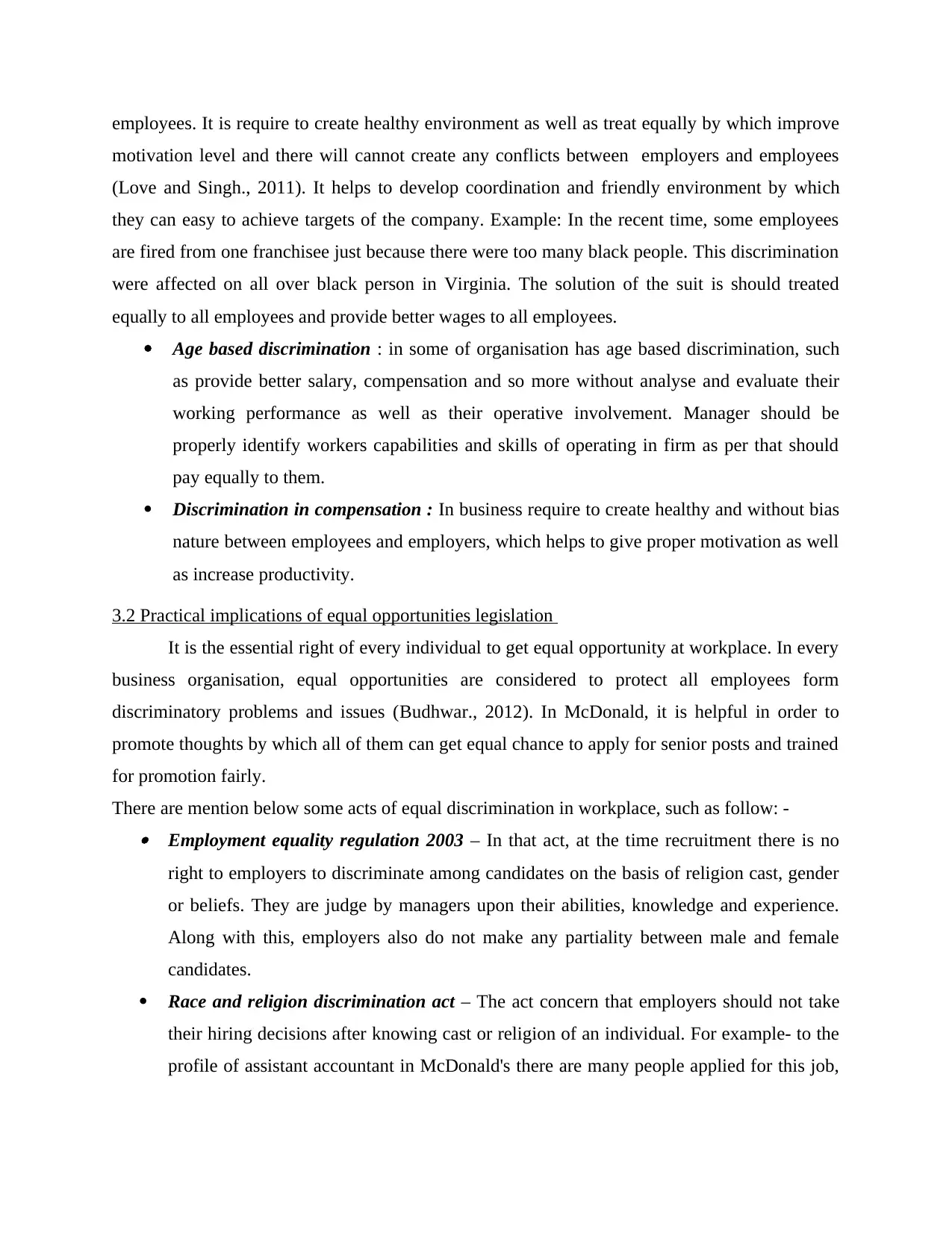
employees. It is require to create healthy environment as well as treat equally by which improve
motivation level and there will cannot create any conflicts between employers and employees
(Love and Singh., 2011). It helps to develop coordination and friendly environment by which
they can easy to achieve targets of the company. Example: In the recent time, some employees
are fired from one franchisee just because there were too many black people. This discrimination
were affected on all over black person in Virginia. The solution of the suit is should treated
equally to all employees and provide better wages to all employees.
Age based discrimination : in some of organisation has age based discrimination, such
as provide better salary, compensation and so more without analyse and evaluate their
working performance as well as their operative involvement. Manager should be
properly identify workers capabilities and skills of operating in firm as per that should
pay equally to them.
Discrimination in compensation : In business require to create healthy and without bias
nature between employees and employers, which helps to give proper motivation as well
as increase productivity.
3.2 Practical implications of equal opportunities legislation
It is the essential right of every individual to get equal opportunity at workplace. In every
business organisation, equal opportunities are considered to protect all employees form
discriminatory problems and issues (Budhwar., 2012). In McDonald, it is helpful in order to
promote thoughts by which all of them can get equal chance to apply for senior posts and trained
for promotion fairly.
There are mention below some acts of equal discrimination in workplace, such as follow: - Employment equality regulation 2003 – In that act, at the time recruitment there is no
right to employers to discriminate among candidates on the basis of religion cast, gender
or beliefs. They are judge by managers upon their abilities, knowledge and experience.
Along with this, employers also do not make any partiality between male and female
candidates.
Race and religion discrimination act – The act concern that employers should not take
their hiring decisions after knowing cast or religion of an individual. For example- to the
profile of assistant accountant in McDonald's there are many people applied for this job,
motivation level and there will cannot create any conflicts between employers and employees
(Love and Singh., 2011). It helps to develop coordination and friendly environment by which
they can easy to achieve targets of the company. Example: In the recent time, some employees
are fired from one franchisee just because there were too many black people. This discrimination
were affected on all over black person in Virginia. The solution of the suit is should treated
equally to all employees and provide better wages to all employees.
Age based discrimination : in some of organisation has age based discrimination, such
as provide better salary, compensation and so more without analyse and evaluate their
working performance as well as their operative involvement. Manager should be
properly identify workers capabilities and skills of operating in firm as per that should
pay equally to them.
Discrimination in compensation : In business require to create healthy and without bias
nature between employees and employers, which helps to give proper motivation as well
as increase productivity.
3.2 Practical implications of equal opportunities legislation
It is the essential right of every individual to get equal opportunity at workplace. In every
business organisation, equal opportunities are considered to protect all employees form
discriminatory problems and issues (Budhwar., 2012). In McDonald, it is helpful in order to
promote thoughts by which all of them can get equal chance to apply for senior posts and trained
for promotion fairly.
There are mention below some acts of equal discrimination in workplace, such as follow: - Employment equality regulation 2003 – In that act, at the time recruitment there is no
right to employers to discriminate among candidates on the basis of religion cast, gender
or beliefs. They are judge by managers upon their abilities, knowledge and experience.
Along with this, employers also do not make any partiality between male and female
candidates.
Race and religion discrimination act – The act concern that employers should not take
their hiring decisions after knowing cast or religion of an individual. For example- to the
profile of assistant accountant in McDonald's there are many people applied for this job,
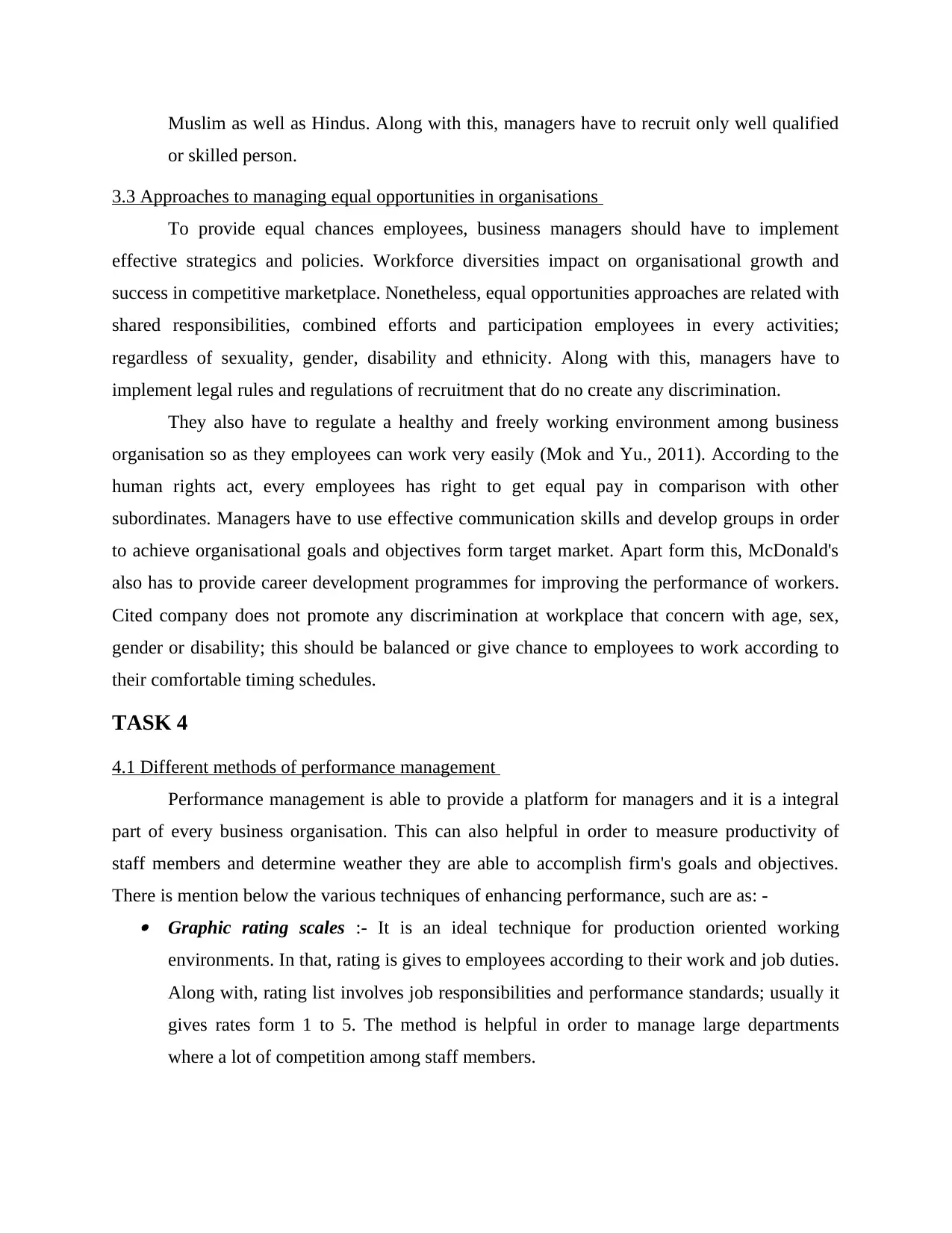
Muslim as well as Hindus. Along with this, managers have to recruit only well qualified
or skilled person.
3.3 Approaches to managing equal opportunities in organisations
To provide equal chances employees, business managers should have to implement
effective strategics and policies. Workforce diversities impact on organisational growth and
success in competitive marketplace. Nonetheless, equal opportunities approaches are related with
shared responsibilities, combined efforts and participation employees in every activities;
regardless of sexuality, gender, disability and ethnicity. Along with this, managers have to
implement legal rules and regulations of recruitment that do no create any discrimination.
They also have to regulate a healthy and freely working environment among business
organisation so as they employees can work very easily (Mok and Yu., 2011). According to the
human rights act, every employees has right to get equal pay in comparison with other
subordinates. Managers have to use effective communication skills and develop groups in order
to achieve organisational goals and objectives form target market. Apart form this, McDonald's
also has to provide career development programmes for improving the performance of workers.
Cited company does not promote any discrimination at workplace that concern with age, sex,
gender or disability; this should be balanced or give chance to employees to work according to
their comfortable timing schedules.
TASK 4
4.1 Different methods of performance management
Performance management is able to provide a platform for managers and it is a integral
part of every business organisation. This can also helpful in order to measure productivity of
staff members and determine weather they are able to accomplish firm's goals and objectives.
There is mention below the various techniques of enhancing performance, such are as: - Graphic rating scales :- It is an ideal technique for production oriented working
environments. In that, rating is gives to employees according to their work and job duties.
Along with, rating list involves job responsibilities and performance standards; usually it
gives rates form 1 to 5. The method is helpful in order to manage large departments
where a lot of competition among staff members.
or skilled person.
3.3 Approaches to managing equal opportunities in organisations
To provide equal chances employees, business managers should have to implement
effective strategics and policies. Workforce diversities impact on organisational growth and
success in competitive marketplace. Nonetheless, equal opportunities approaches are related with
shared responsibilities, combined efforts and participation employees in every activities;
regardless of sexuality, gender, disability and ethnicity. Along with this, managers have to
implement legal rules and regulations of recruitment that do no create any discrimination.
They also have to regulate a healthy and freely working environment among business
organisation so as they employees can work very easily (Mok and Yu., 2011). According to the
human rights act, every employees has right to get equal pay in comparison with other
subordinates. Managers have to use effective communication skills and develop groups in order
to achieve organisational goals and objectives form target market. Apart form this, McDonald's
also has to provide career development programmes for improving the performance of workers.
Cited company does not promote any discrimination at workplace that concern with age, sex,
gender or disability; this should be balanced or give chance to employees to work according to
their comfortable timing schedules.
TASK 4
4.1 Different methods of performance management
Performance management is able to provide a platform for managers and it is a integral
part of every business organisation. This can also helpful in order to measure productivity of
staff members and determine weather they are able to accomplish firm's goals and objectives.
There is mention below the various techniques of enhancing performance, such are as: - Graphic rating scales :- It is an ideal technique for production oriented working
environments. In that, rating is gives to employees according to their work and job duties.
Along with, rating list involves job responsibilities and performance standards; usually it
gives rates form 1 to 5. The method is helpful in order to manage large departments
where a lot of competition among staff members.
⊘ This is a preview!⊘
Do you want full access?
Subscribe today to unlock all pages.

Trusted by 1+ million students worldwide
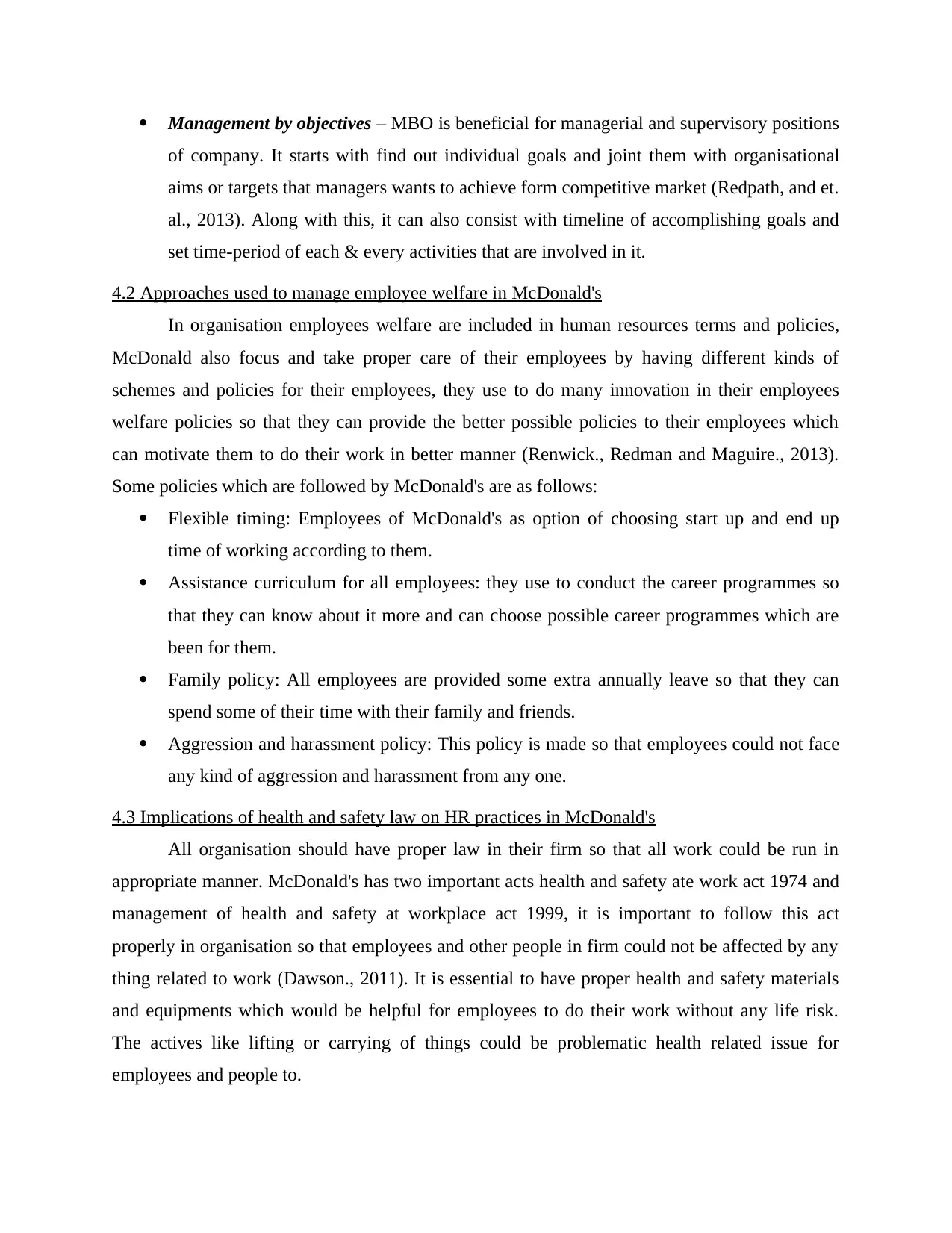
Management by objectives – MBO is beneficial for managerial and supervisory positions
of company. It starts with find out individual goals and joint them with organisational
aims or targets that managers wants to achieve form competitive market (Redpath, and et.
al., 2013). Along with this, it can also consist with timeline of accomplishing goals and
set time-period of each & every activities that are involved in it.
4.2 Approaches used to manage employee welfare in McDonald's
In organisation employees welfare are included in human resources terms and policies,
McDonald also focus and take proper care of their employees by having different kinds of
schemes and policies for their employees, they use to do many innovation in their employees
welfare policies so that they can provide the better possible policies to their employees which
can motivate them to do their work in better manner (Renwick., Redman and Maguire., 2013).
Some policies which are followed by McDonald's are as follows:
Flexible timing: Employees of McDonald's as option of choosing start up and end up
time of working according to them.
Assistance curriculum for all employees: they use to conduct the career programmes so
that they can know about it more and can choose possible career programmes which are
been for them.
Family policy: All employees are provided some extra annually leave so that they can
spend some of their time with their family and friends.
Aggression and harassment policy: This policy is made so that employees could not face
any kind of aggression and harassment from any one.
4.3 Implications of health and safety law on HR practices in McDonald's
All organisation should have proper law in their firm so that all work could be run in
appropriate manner. McDonald's has two important acts health and safety ate work act 1974 and
management of health and safety at workplace act 1999, it is important to follow this act
properly in organisation so that employees and other people in firm could not be affected by any
thing related to work (Dawson., 2011). It is essential to have proper health and safety materials
and equipments which would be helpful for employees to do their work without any life risk.
The actives like lifting or carrying of things could be problematic health related issue for
employees and people to.
of company. It starts with find out individual goals and joint them with organisational
aims or targets that managers wants to achieve form competitive market (Redpath, and et.
al., 2013). Along with this, it can also consist with timeline of accomplishing goals and
set time-period of each & every activities that are involved in it.
4.2 Approaches used to manage employee welfare in McDonald's
In organisation employees welfare are included in human resources terms and policies,
McDonald also focus and take proper care of their employees by having different kinds of
schemes and policies for their employees, they use to do many innovation in their employees
welfare policies so that they can provide the better possible policies to their employees which
can motivate them to do their work in better manner (Renwick., Redman and Maguire., 2013).
Some policies which are followed by McDonald's are as follows:
Flexible timing: Employees of McDonald's as option of choosing start up and end up
time of working according to them.
Assistance curriculum for all employees: they use to conduct the career programmes so
that they can know about it more and can choose possible career programmes which are
been for them.
Family policy: All employees are provided some extra annually leave so that they can
spend some of their time with their family and friends.
Aggression and harassment policy: This policy is made so that employees could not face
any kind of aggression and harassment from any one.
4.3 Implications of health and safety law on HR practices in McDonald's
All organisation should have proper law in their firm so that all work could be run in
appropriate manner. McDonald's has two important acts health and safety ate work act 1974 and
management of health and safety at workplace act 1999, it is important to follow this act
properly in organisation so that employees and other people in firm could not be affected by any
thing related to work (Dawson., 2011). It is essential to have proper health and safety materials
and equipments which would be helpful for employees to do their work without any life risk.
The actives like lifting or carrying of things could be problematic health related issue for
employees and people to.
Paraphrase This Document
Need a fresh take? Get an instant paraphrase of this document with our AI Paraphraser
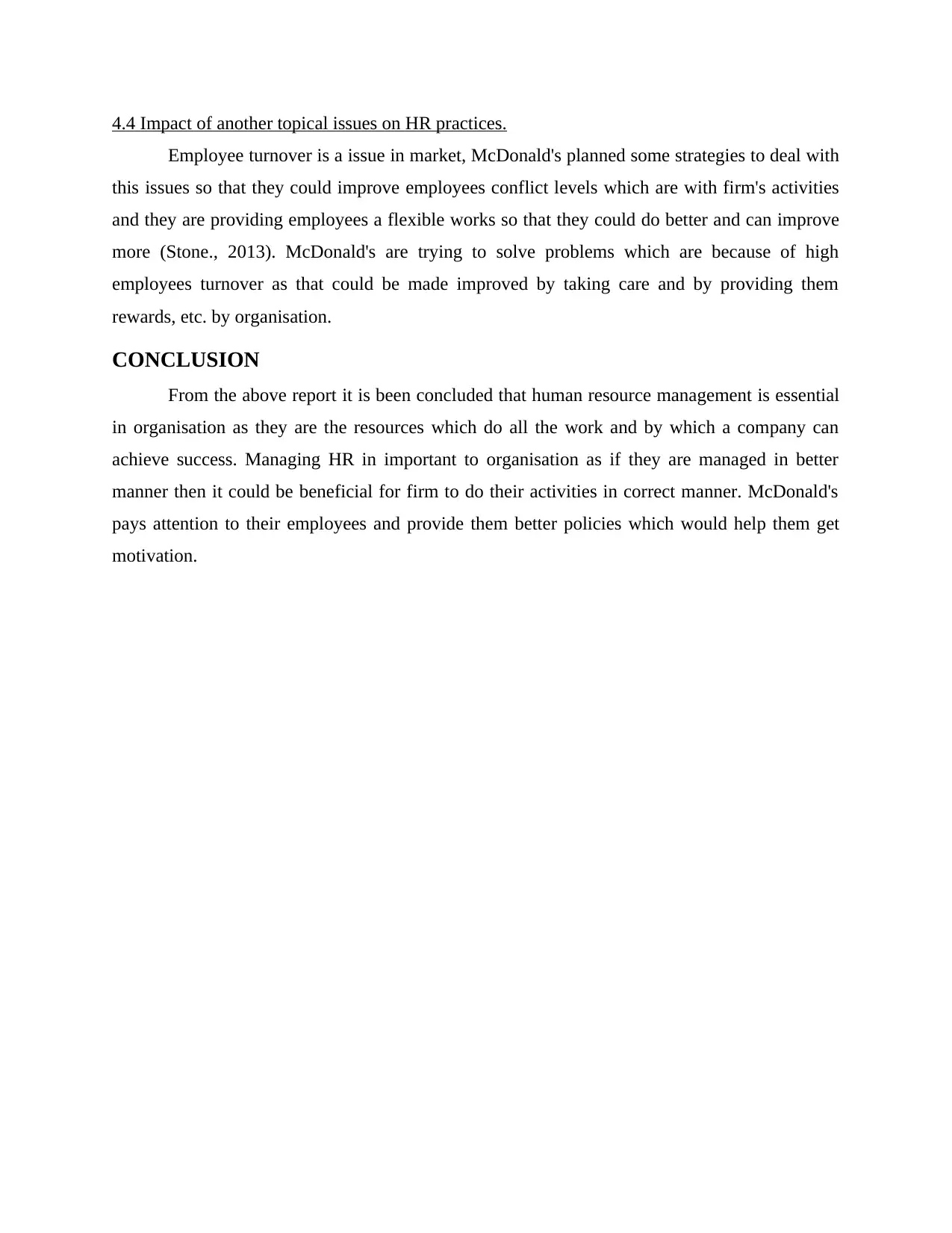
4.4 Impact of another topical issues on HR practices.
Employee turnover is a issue in market, McDonald's planned some strategies to deal with
this issues so that they could improve employees conflict levels which are with firm's activities
and they are providing employees a flexible works so that they could do better and can improve
more (Stone., 2013). McDonald's are trying to solve problems which are because of high
employees turnover as that could be made improved by taking care and by providing them
rewards, etc. by organisation.
CONCLUSION
From the above report it is been concluded that human resource management is essential
in organisation as they are the resources which do all the work and by which a company can
achieve success. Managing HR in important to organisation as if they are managed in better
manner then it could be beneficial for firm to do their activities in correct manner. McDonald's
pays attention to their employees and provide them better policies which would help them get
motivation.
Employee turnover is a issue in market, McDonald's planned some strategies to deal with
this issues so that they could improve employees conflict levels which are with firm's activities
and they are providing employees a flexible works so that they could do better and can improve
more (Stone., 2013). McDonald's are trying to solve problems which are because of high
employees turnover as that could be made improved by taking care and by providing them
rewards, etc. by organisation.
CONCLUSION
From the above report it is been concluded that human resource management is essential
in organisation as they are the resources which do all the work and by which a company can
achieve success. Managing HR in important to organisation as if they are managed in better
manner then it could be beneficial for firm to do their activities in correct manner. McDonald's
pays attention to their employees and provide them better policies which would help them get
motivation.
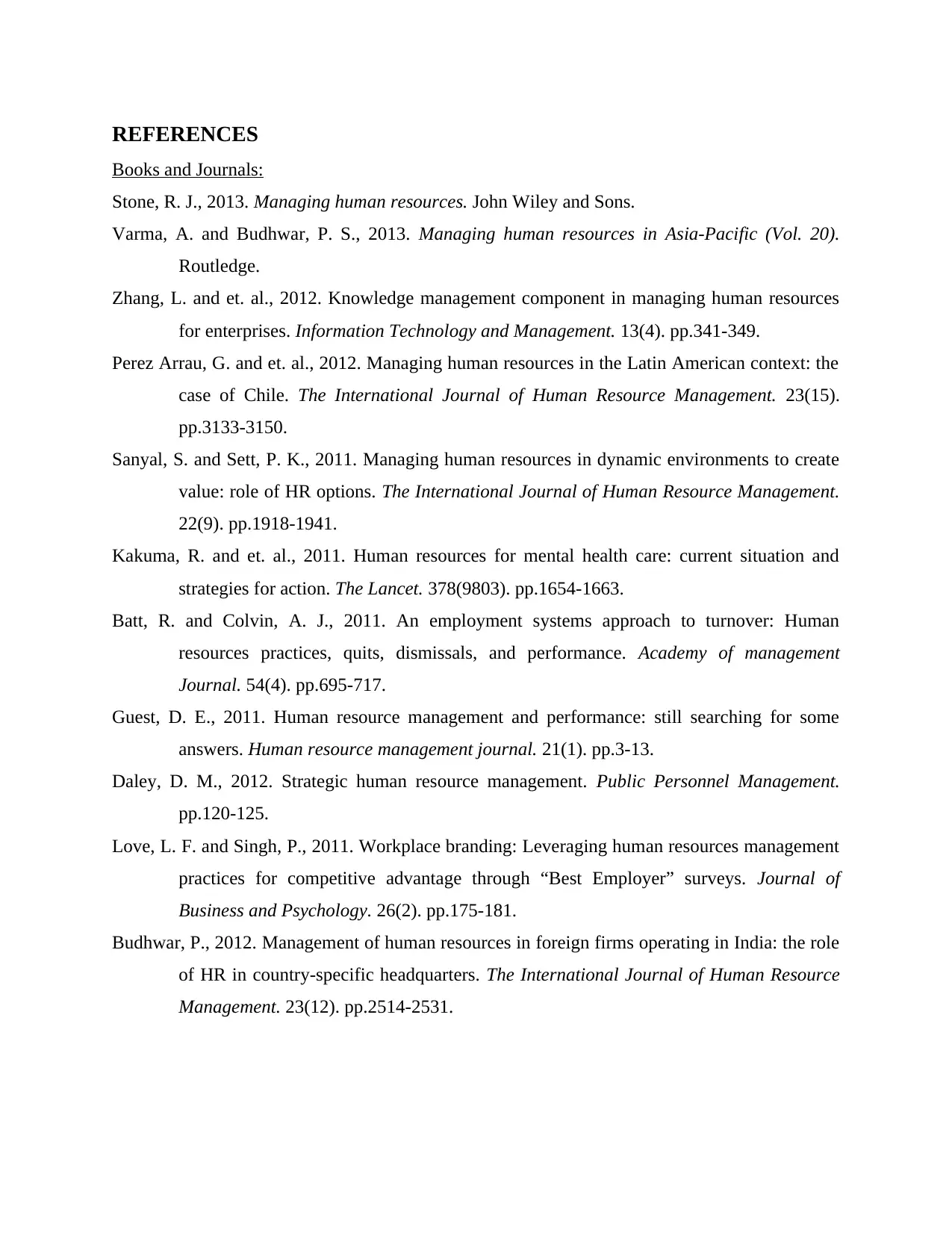
REFERENCES
Books and Journals:
Stone, R. J., 2013. Managing human resources. John Wiley and Sons.
Varma, A. and Budhwar, P. S., 2013. Managing human resources in Asia-Pacific (Vol. 20).
Routledge.
Zhang, L. and et. al., 2012. Knowledge management component in managing human resources
for enterprises. Information Technology and Management. 13(4). pp.341-349.
Perez Arrau, G. and et. al., 2012. Managing human resources in the Latin American context: the
case of Chile. The International Journal of Human Resource Management. 23(15).
pp.3133-3150.
Sanyal, S. and Sett, P. K., 2011. Managing human resources in dynamic environments to create
value: role of HR options. The International Journal of Human Resource Management.
22(9). pp.1918-1941.
Kakuma, R. and et. al., 2011. Human resources for mental health care: current situation and
strategies for action. The Lancet. 378(9803). pp.1654-1663.
Batt, R. and Colvin, A. J., 2011. An employment systems approach to turnover: Human
resources practices, quits, dismissals, and performance. Academy of management
Journal. 54(4). pp.695-717.
Guest, D. E., 2011. Human resource management and performance: still searching for some
answers. Human resource management journal. 21(1). pp.3-13.
Daley, D. M., 2012. Strategic human resource management. Public Personnel Management.
pp.120-125.
Love, L. F. and Singh, P., 2011. Workplace branding: Leveraging human resources management
practices for competitive advantage through “Best Employer” surveys. Journal of
Business and Psychology. 26(2). pp.175-181.
Budhwar, P., 2012. Management of human resources in foreign firms operating in India: the role
of HR in country-specific headquarters. The International Journal of Human Resource
Management. 23(12). pp.2514-2531.
Books and Journals:
Stone, R. J., 2013. Managing human resources. John Wiley and Sons.
Varma, A. and Budhwar, P. S., 2013. Managing human resources in Asia-Pacific (Vol. 20).
Routledge.
Zhang, L. and et. al., 2012. Knowledge management component in managing human resources
for enterprises. Information Technology and Management. 13(4). pp.341-349.
Perez Arrau, G. and et. al., 2012. Managing human resources in the Latin American context: the
case of Chile. The International Journal of Human Resource Management. 23(15).
pp.3133-3150.
Sanyal, S. and Sett, P. K., 2011. Managing human resources in dynamic environments to create
value: role of HR options. The International Journal of Human Resource Management.
22(9). pp.1918-1941.
Kakuma, R. and et. al., 2011. Human resources for mental health care: current situation and
strategies for action. The Lancet. 378(9803). pp.1654-1663.
Batt, R. and Colvin, A. J., 2011. An employment systems approach to turnover: Human
resources practices, quits, dismissals, and performance. Academy of management
Journal. 54(4). pp.695-717.
Guest, D. E., 2011. Human resource management and performance: still searching for some
answers. Human resource management journal. 21(1). pp.3-13.
Daley, D. M., 2012. Strategic human resource management. Public Personnel Management.
pp.120-125.
Love, L. F. and Singh, P., 2011. Workplace branding: Leveraging human resources management
practices for competitive advantage through “Best Employer” surveys. Journal of
Business and Psychology. 26(2). pp.175-181.
Budhwar, P., 2012. Management of human resources in foreign firms operating in India: the role
of HR in country-specific headquarters. The International Journal of Human Resource
Management. 23(12). pp.2514-2531.
⊘ This is a preview!⊘
Do you want full access?
Subscribe today to unlock all pages.

Trusted by 1+ million students worldwide
1 out of 13
Related Documents
Your All-in-One AI-Powered Toolkit for Academic Success.
+13062052269
info@desklib.com
Available 24*7 on WhatsApp / Email
![[object Object]](/_next/static/media/star-bottom.7253800d.svg)
Unlock your academic potential
Copyright © 2020–2025 A2Z Services. All Rights Reserved. Developed and managed by ZUCOL.





